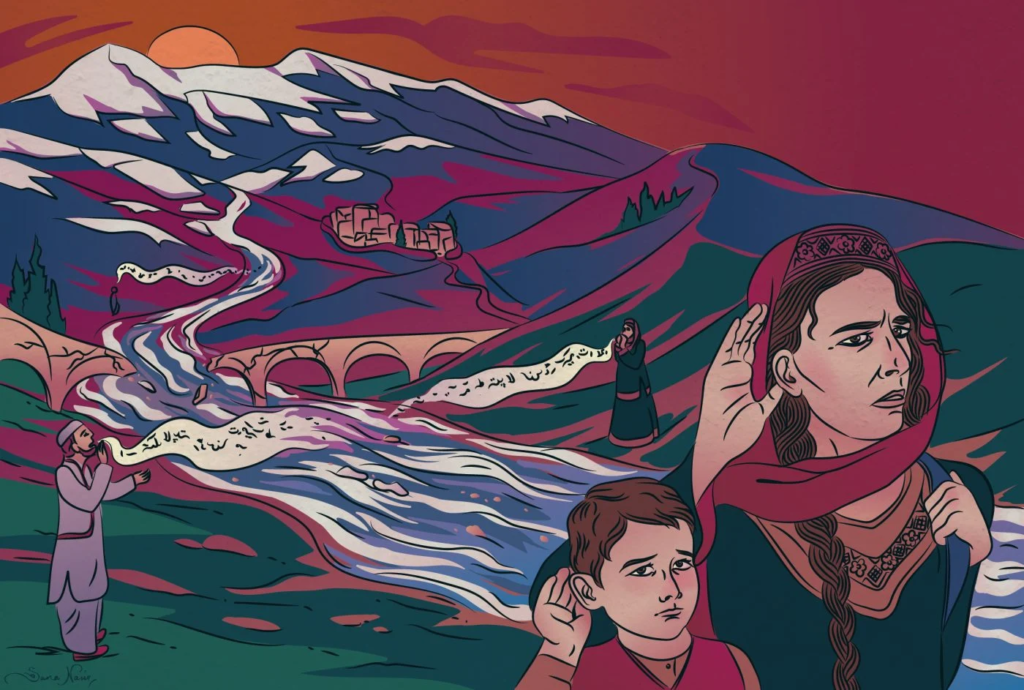موسمیاتی آفات کی وجہ سے پہاڑی علاقوں میں مکین ہجرت کرنے پر مجبور ہیں اور اس عمل میں ان کی زبانیں اور ثقافتیں شدید متاثر ہو رہی ہیں۔
فواد علی
شمالی پاکستان میں 2010 کا سیلاب اور اس کے دردناک مناظر، تورولی-کوہستانی لغت نگار، انعام توروالی کی یادداشت میں اب بھی تازہ ہیں۔ پاکستان کی تاریخ کے بدترین انسانی تباہی میں سے ایک، اس سیلاب کی وجہ سے گلگت بلتستان اور خیبر پختونخواہ کے شمالی پہاڑی علاقوں سے بڑے پیمانے پر نقل مکانی ہوئی۔ تورولی سمیت کتنے ہی لوگوں کے گھر تباہ ہوگئے۔ ان کے کھیت پانی میں ڈوب گۓ جس کی وجہ سے وہ اور ان کے خاندان کو پشتون اکثریتی مینگورہ شہر کی طرف ہجرت کرنی پڑی جو ضلع سوات میں ان کے آبائی شہر سے 59 کلومیٹر دور ہے۔
تباہی کے اثرات اب بھی باقی ہیں۔ جن میں واضح طور پر ان کی آبائی زبان توروالی کو لاحق خطرہ ہے۔ انہوں نے ڈائیلاگ ارتھ کو بتایا، “شہروں کی طرف ہجرت کرنے والے نوجوان، اب غالب زبانوں؛ جیسے، پنجابی، پشتو اور اردو کے بہت سے مستعار الفاظ کے ساتھ یا تو ایک مختلف تورولی بولی بول رہے ہیں، یا بالکل بھی نہیں بول سکتے۔ ان کے بھتیجے اب پشتو بولتے ہیں، جو صوبے کی زبان ہے۔
توروالی کہتے ہیں، “موسمیاتی تبدیلیوں سے پیدا ہونے والے بحران کی شدّت سے متعلق پہاڑی کمیونٹیز کے پاس کوئی علم نہیں اور اس سے نمٹنے کے لئے کسی قسم کی حکمت عملی سے یہ لاعلم ہیں”۔ مزید براں، گلگت بلتستان کی آب و ہوا کی حکمت عملی ہجرت، اور نقل مکانی کرنے والوں کی ترسیلات کو ایک مثبت موافقت کی حکمت عملی کے طور پر پیش کرتی ہے۔ خیبر پختونخواہ کی موسمی حکمت عملی موسمی تبدیلی کے تحت نقل مکانی کو تسلیم کرتی ہے لیکن اس کی موافقت کی حکمت عملی آنے والے مہاجرین کے لئے بہتر شہری منصوبہ بندی کے حوالے سے محدود ہے۔ نہ ہی یہ تسلیم کیا جاتا ہے کہ آب و ہوا کی وجہ سے نقل مکانی، شمالی پاکستان کی ثقافتوں اور زبانوں کو کس طرح متاثر کر سکتی ہے۔
پہاڑی خطّوں میں چھوٹی آبادیاں غیر محفوظ ہیں
پاکستان کے پہاڑی شمالی علاقوں میں 30 سے زیادہ ‘خطرے سے دوچار‘ زبانیں بولی جاتی ہیں۔ اس کا مطلب ہے کہ ان میں سے بہت سی زبانیں صرف چھوٹی آبادی میں بولی جاتی ہیں، جو کہ چند ہزار پر مشتمل ہیں۔ اس خطّے میں آباد کمیونٹیز متعدد موسمی آفات کے خطرے سے بھی دوچار ہیں۔ 500 سے زائد گلیشیئرز رکھنے والے ضلع چترال کو، “17 سالوں میں 2021 تک، 13 سے زیادہ برفانی سیلابوں کا سامنا کرنا پڑا، کئی گھرانے بے گھر ہوۓ اور وہ سالوں تک عارضی پناہ گاہوں میں رہنے پر مجبور رہے”۔ گلگت بلتستان میں 2010 کے سیلاب کے علاوہ 1999 سے 2017 تک 15 گلوف (جی ایل او ایف) واقعات ریکارڈ کئے گئے۔
چھوٹی آبادی کی بولی جانے والی زبانوں پر ان آفات کا بلواسطہ گہرا اثر ہے۔ مثال کے طور پر، جب 2018 میں گلگت بلتستان کے ضلع غذر کا گاؤں بدسوات ایک گلوف (جی ایل او ایف) کا نشانہ بنا، تو واکھی زبان بولنے والے خاندانوں کو مجبوراً گلگت شہر منتقل ہونا پڑا۔ واکھی صرف 40,000 لوگ بولتے ہیں اور یہ گلگت شہر کی زبان نہیں ہے، یہاں نئے مہاجرین کو شینا یا پاکستان کی سرکاری زبان اردو میں بات چیت کرنا سیکھنا پڑا۔
لیکن شینا خود بھی ایسے ہی عوامل کی وجہ سے خطرے کی زد میں ہے۔ گلگت سے تعلق رکھنے والے زبانوں کے محقق محمد وزیر بیگ نے بتایا کہ ان کے بہت سے رشتہ دار جو 1978 اور 2010 کے سیلاب میں اپنا گھر کھو بیٹھے تھے وہ کراچی منتقل ہو گئے ہیں۔ انہوں نے کہا کہ، ” جب میں گزشتہ اکتوبر ان سے ملا تو میں نے ان سب کو شینا کے بجائے اردو بولتے ہوئے پایا۔
A displacement of people and culture
Mass displacement forces mountain populations to learn new languages, and it also distances them from the geography that shaped these languages, said Fakhruddin Akhunzada, director of the Islamabad-based Forum for Language Initiative (FLI), which is dedicated to preserving endangered languages in Chitral.
“These languages evolved in specific environments rich with livestock, farming, rivers, snow, and forested high mountains – all of which are now at risk due to climate change,” Akhunzada said. These languages lose their value to the people displaced to other regions, he explained, and the displaced populations no longer observe cultural festivals, tell traditional stories, or communicate in their mother tongue. This leads to a gradual loss of proficiency in their native languages.
When these distressed families relocate… they are compelled to speak the dominant language
Amjid Saleem, University of Peshawar
Samiullah Arman, who teaches at Edward College, Peshawar explains this as a fall in the “market value” of the language, in that it does not help people navigate their surroundings. “The higher the market value of a language, the more people will speak it, and it will thrive,” said Arman, who also heads the Language, Literature and Culture Department at Mafkoora, a research and development organisation working for the preservation of local languages.
Agreeing with Arman, Amjid Saleem, head of the English and Applied Linguistics Department at the University of Peshawar, told Dialogue Earth that displacement due to natural disasters is not just the displacement of individuals but rather of cultures. “When these distressed families relocate… they are compelled to speak the dominant language as their native tongue is rarely spoken… in schools and marketplaces… They quickly try to learn the dominant language to overcome their sense of alienation, and this way a language erodes slowly and gradually,” he said.
Languages only spoken at home
Dr Rubina Sethi, a retired teacher at the Department of English and Applied Linguistics, University of Peshawar, emphasised that women play a crucial role in preserving a language, but the influence of this preservation depends on what children encounter outside their homes. “While the language may be cherished and close to their hearts inside their houses, its lack of utility outside compels them to adopt the dominant language” of the region to which they have been displaced, she explained.
Confirming this, Asmatullah Dameli, a researcher who compiled the alphabet of the Dameli language in 2000, told Dialogue Earth, “We prefer to speak our mother tongue [only] inside our homes… [it] is undeniable that a time will come that coming generations will not be able to speak it.” The Dameli language is spoken only by about 5,000 people, and – according to the Damel Welfare Society in Chitral district that works for the preservation of the language – around 40% of that population migrated to different cities in the aftermath of the 2010 floods.
Lack of solid data limits what can be done
Migration is driven by multiple factors, and it is difficult to establish a linear and causative relationship between climate change and forced migration.
Nonetheless, Dr Owais Ahmad, a professor of Environmental Sociology at the Sociology Department at the University of Peshawar, said climate change is the primary driver of migration from the northern regions of Khyber Pakhtunkhwa and Gilgit-Baltistan, particularly after 2010. “People would do everything to survive another major disaster [and] feed their families, so they come downhill alone or along with their families,” he said.
Inam Torwali, in his research study titled, Future of Torwali Migrants in Urban Cities, states that 90% of migrant families have not returned to their home towns due to financial constraints. Muhammad Wali, a researcher dedicated to preserving the Yidgha language, an ancient Iranian language spoken by only 6,000 people, added, “Climate change has exacerbated the already dire poverty [in mountainous regions] and accelerated migration. Those with the means to migrate have already done so, leaving behind only those lacking the necessary resources.”
Just as the state needs to study climate change and migration, Arman said it should integrate the issue of language loss into climate change policies as part of a strategy to prevent further erosion of cultures. Saleem concurred, adding, “It is the state’s responsibility to take steps to include all languages in the curriculum and ensure they are taught to children of migrating families if it aims to preserve smaller languages.”
یہ مضمون اصل میں دی تھرڈ پول پر کریٸیٹو کامنز لاٸنسنس کے تحت شاٸع ہوا ہے۔



